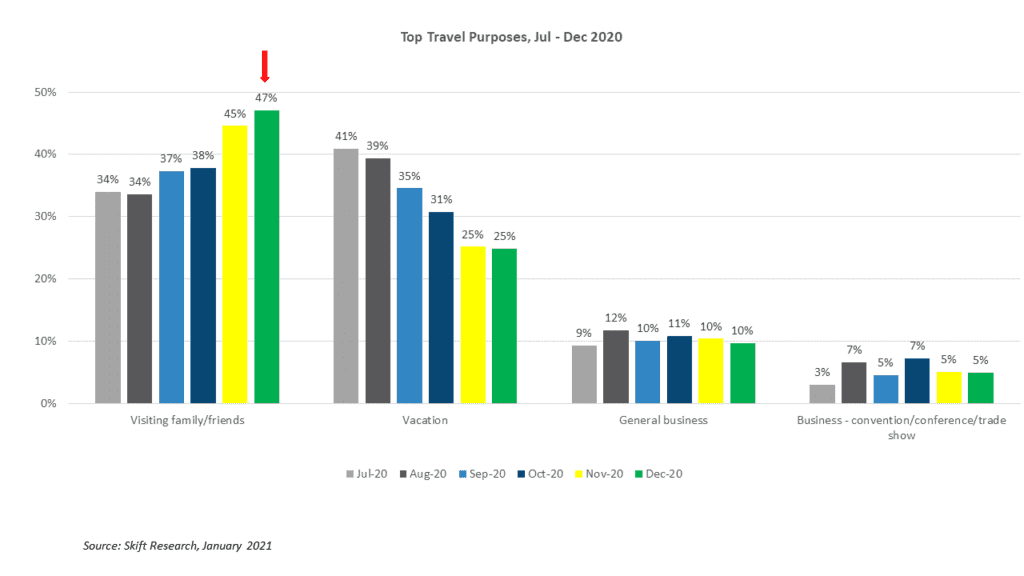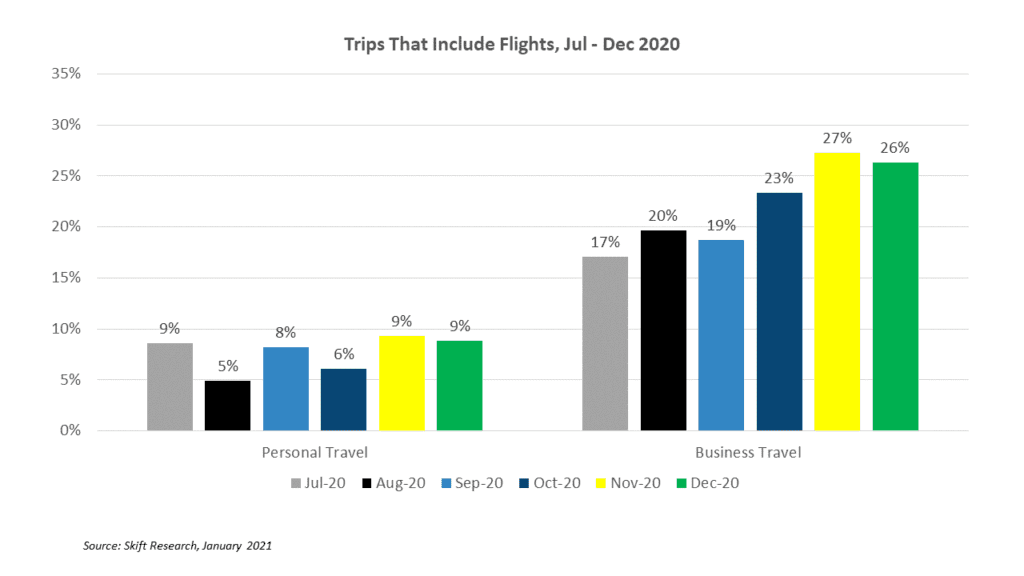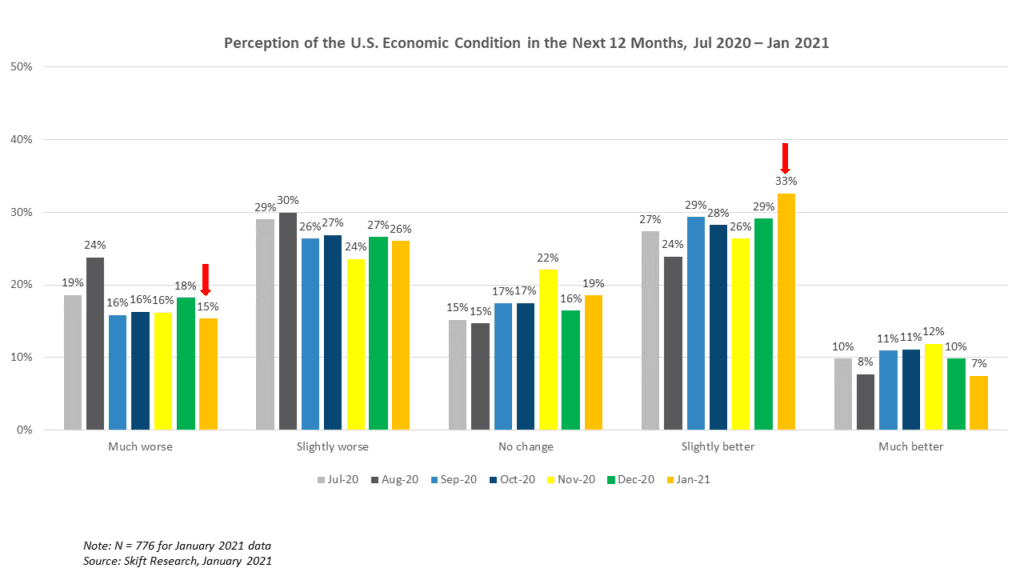United Airlines cut hard and cut deep when the coronavirus pandemic hit a year ago. As the largest U.S. airline to China, it cut more flights earlier than any of its American competitors — something it continued as it became clear that the virus would upend life around the world.
The Chicago-based carrier maintains what can best be described as a realist view of the crisis a year on. Speaking during United’s fourth-quarter earnings call last week, CEO Scott Kirby told Wall Street analysts and investors not to fear, travelers will return but not to expect them back in significant numbers until sometime after June.
“We will, sometime this year, hit that [inflection] point,” Kirby said. “Then there’ll be a very steep increase in demand.” That recovery could see travel demand return to as much as 85% or 90% of 2019 levels, he added.
Leisure flyers will be back first, as they have throughout the pandemic. That burst will be driven by the pent-up demand — whether to visit family only seen on FaceTime or just to escape to the beach — that industry leaders repeatedly cite.
Corporate travelers will lag holidaygoers — maybe by a lot. United maintains its view that this critical business segment will take 18- to 24-months to recover, or until around 2023, said commercial chief Andrew Nocella.
This is more pessimistic than competitor Delta Air Lines. In its own forecast, the Atlanta-based carrier cited findings from an internal a survey of large corporate customers that as many as 40% plan to return to 2019 levels of travel spending by the end of this year. This view, plus a strong domestic franchise, has the airline forecasting a return to profitability as soon as this summer.
Critical to both outlooks is the as yet slow roll out of Covid-19 vaccines. President Joseph Biden aims to vaccinate 100 million Americans in his first 90 days. If achieved, that number would go a long way towards boosting airlines.
International Profits
United executives do not expect a big benefit from the coming rush of holiday-goers. The airline’s hubs in major coastal business centers and smaller size domestically puts it at a disadvantage to competitors like American Airlines and Delta in a leisure-first recovery. In addition, opportunistic growth plays by players like JetBlue Airways, Southwest Airlines and Spirit Airlines are only likely to ratchet up pressure on United’s domestic franchise.
For example, Southwest has unveiled or added 12 new U.S. destinations to its map since Covid-19 hit. These include a number of small communities dominated by United prior to the crisis, including Montrose and Steamboat Springs in Colorado, and Santa Barbara, Calif.
This is where United has a trump card. As the largest international U.S. carrier prior to Covid-19, executives think they can leverage this position to capture an even larger share of the market post-coronavirus. Already, the airline has unveiled plans to add three new destinations in Africa, including Accra, Johannesburg and Lagos, and expand flying to India, including new service to Bangalore. India is a market where U.S. airlines have long claimed a competitive disadvantage to their Persian Gulf-based competitors.
“Traditional major markets in Europe and Asia will recover in 2022, but we expect emerging international markets to be stronger in the near term,” said Nocella. The route map additions fit with a view that emerging markets will come back first.
New U.S. testing requirements for arriving travelers are expected to put a damper on near-term demand but accelerate the long-term recovery as confidence grows in the processes, he added.
“We are increasingly confident that within three years, international margins for North American airlines can exceed pre-Covid-19 levels and possibly their corresponding domestic levels,” wrote J.P. Morgan analyst Jamie Baker, affirming United’s view in a report.
Restructurings at international competitors also pose an opportunity for United. Nocella cited the decision by Norwegian Air — “one big competitor” as he described the carrier — to end long-haul flying as an immediate boost to its transatlantic business. Another benefit is the removal of many large widebody jets, like Airbus A380s and Boeing 747s, at foreign airlines. These retirements will reduce the number of seats on long-haul routes and allow airlines to raise fares once demand returns.
On the latter point, take the Paris-Washington market where Air France and United compete. The former flew Airbus A380s with 516 seats on the route during peak months prior to Covid-19, Cirum schedules show. Air France has since retired its fleet of superjumbos and is flying Boeing 777-300ERs with room for 296 passengers — a nearly 43% cut in seats — on the route.
United has only retired 13 older Boeing 757s and no widebody aircraft in the crisis. Executives argue that the cost of storing planes is minimal and keeping them on their certificate gives the airline the “flexibility” to ramp up service quickly when demand returns.
“The world is very different on the international front over the next cycle,” said Nocella. And, at least if you ask him, United is well positioned to benefit from that change.
Fourth-Quarter Numbers
United lost $2.37 billion before taxes during the final three months of 2020. The loss followed a 69% drop in operating revenues to $3.4 billion and a 45% drop in operating expenses to $5.5 billion. The carrier’s daily cash burn rose $7 million a day to an average of $33 million on the back of higher debt payments compared to the third quarter.
For the full year, United reported an $8.8 billion pre-tax loss on $15.4 billion in operating revenues. The airline flew 69% less passenger traffic on a 57% capacity cut in 2020.
“We don’t expect a material improvement over the fourth-quarter revenue results based on what we see today,” said Nocella on the outlook for the first quarter. Capacity is expected to be down 51% year-over-year in the period. He did not provide cash burn guidance.
United will re-introduce the Boeing 737 Max after nearly two-years in storage on February 11. The airline will fly the jet on 12 routes from its Denver and Houston hubs initially.
By the Numbers: Travel Demand This Year
Visiting friends and relatives (VFR) travel was the primary driver of demand last year, Skift Research found in its “U.S. Travel Tracker: December 2020” report. Almost half of all travel last year was VFR, with business travel accounting for only 5% of demand. Looking ahead, only about 1/3 of those surveyed thought the U.S. economy would improve this year. (Source: Skift Research)



In Other News
- It finally happened. After months of uncertainty due to the pandemic, the IAG-Air Europa deal is going through. But the waiting paid off for IAG. It is buying Air Europa for €500 million ($606 million), or half of the €1 billion it offered last year. Acquiring Air Europe gives another Spanish airline, after Iberia and Vueling.
- Norwegian is getting another bailout from Norway’s government. The new funds are conditioned on private investment in the company and on the airline hewing to the business plan it outlined last week. The plan includes giving up its longhaul operation and shrinking down to 50 narrowbody aircraft.
- In a worrying new sign that the recovery may be further off than anticipated, Chinese hotels have reported a decline in bookings. By late last year, domestic China airline traffic had reached its pre-pandemic levels, and hotel bookings were approaching the same. But new Covid flare-ups around the country have put a dampener on the recovery. Revenue per room, a key hotel-industry metric, plunged more than 40% in the first two weeks of the year.
- South Korea’s Eastar Jet has filed for administration, the country’s equivalent to bankruptcy protection. The company says it will use the process to restructure. Whether it will take delivery of the four Boeing 737s it has in its orderbook remains to be seen, however. Jeju Air had considered acquiring Eastar last year, but those talks fell through over the summer.
- HNA Group, which owns Hainan Airlines and stakes in a number of other carriers, said the government-led working group overseeing its debt crisis soon could recommend a solution to the conglomerate’s financial problems. The government clipped its wings a few years ago, ordering it to dispose of many of its assets and focus on its aviation business. The airlines it operates dramatically cut capacity last year. In October, for example, while other Chinese airlines were adding capacity, Hainan cut ASKs by 36%.